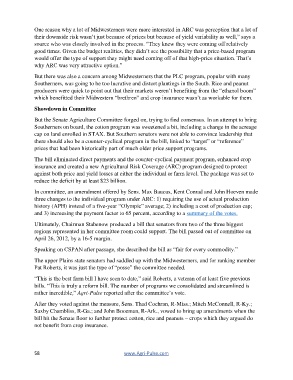Page 60 - Farm Bill Series_The 7 Things You Should Know
P. 60
One reason why a lot of Midwesterners were more interested in ARC was perception that a lot of
their downside risk wasn’t just because of prices but because of yield variability as well,” says a
source who was closely involved in the process. “They knew they were coming off relatively
good times. Given the budget realities, they didn’t see the possibility that a price-based program
would offer the type of support they might need coming off of that high-price situation. That’s
why ARC was very attractive option.”
But there was also a concern among Midwesterners that the PLC program, popular with many
Southerners, was going to be too lucrative and distort plantings in the South. Rice and peanut
producers were quick to point out that their markets weren’t benefiting from the “ethanol boom”
which benefitted their Midwestern “brethren” and crop insurance wasn’t as workable for them.
Showdown in Committee
But the Senate Agriculture Committee forged on, trying to find consensus. In an attempt to bring
Southerners on board, the cotton program was sweetened a bit, including a change in the acreage
cap on land enrolled in STAX. But Southern senators were not able to convince leadership that
there should also be a counter-cyclical program in the bill, linked to “target” or “reference”
prices that had been historically part of much older price support programs.
The bill eliminated direct payments and the counter-cyclical payment program, enhanced crop
insurance and created a new Agricultural Risk Coverage (ARC) program designed to protect
against both price and yield losses at either the individual or farm level. The package was set to
reduce the deficit by at least $23 billion.
In committee, an amendment offered by Sens. Max Baucus, Kent Conrad and John Hoeven made
three changes to the individual program under ARC: 1) requiring the use of actual production
history (APH) instead of a five-year “Olympic” average; 2) including a cost of production cap;
and 3) increasing the payment factor to 65 percent, according to a summary of the votes.
Ultimately, Chairman Stabenow produced a bill that senators from two of the three biggest
regions represented in her committee room could support. The bill passed out of committee on
April 26, 2012, by a 16-5 margin.
Speaking on CSPAN after passage, she described the bill as “fair for every commodity.”
The upper Plains state senators had saddled up with the Midwesterners, and for ranking member
Pat Roberts, it was just the type of “posse” the committee needed.
“This is the best farm bill I have seen to date,” said Roberts, a veteran of at least five previous
bills. “This is truly a reform bill. The number of programs we consolidated and streamlined is
rather incredible,” Agri-Pulse reported after the committee’s vote.
After they voted against the measure, Sens. Thad Cochran, R-Miss.; Mitch McConnell, R-Ky.;
Saxby Chambliss, R-Ga.; and John Boozman, R-Ark., vowed to bring up amendments when the
bill hit the Senate floor to further protect cotton, rice and peanuts – crops which they argued do
not benefit from crop insurance.
58 www.Agri-Pulse.com

